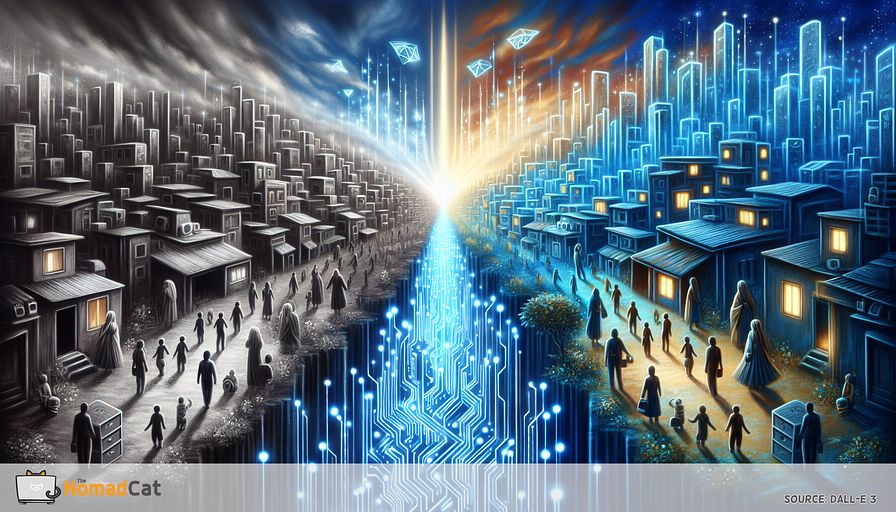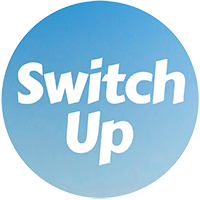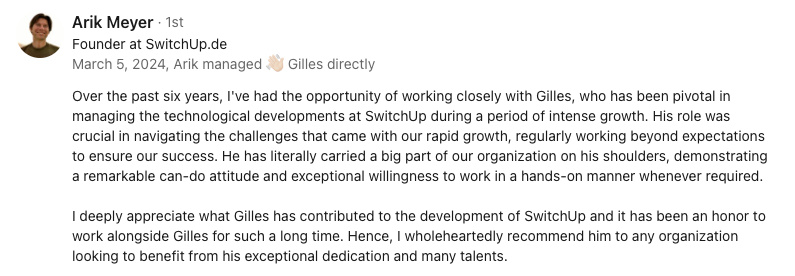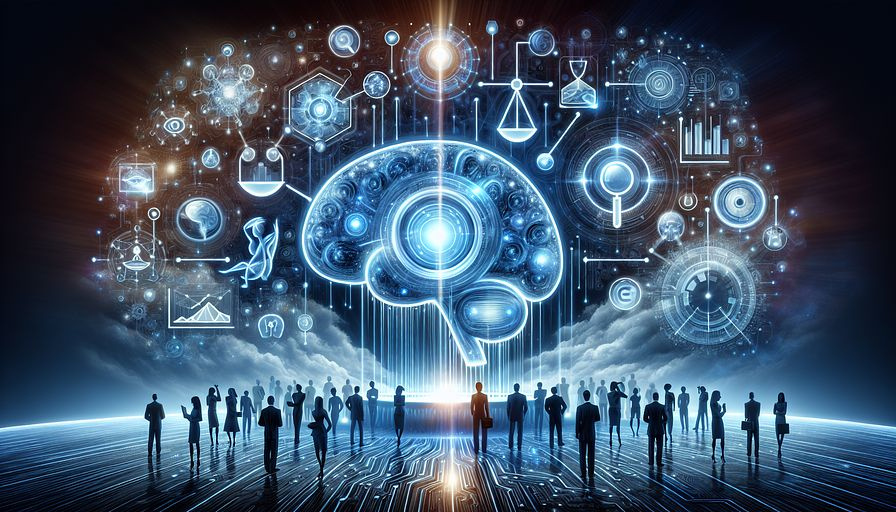Abstract:
In an era where technology influences nearly every aspect of our lives, the power of digital education to transform communities, especially those that are underprivileged, cannot be overstated. This article explores how digital learning platforms and resources offer an unprecedented opportunity to bridge educational gaps. It showcases successful initiatives that have made education accessible to all, regardless of socio-economic status, and discusses the critical role of technology in democratizing education. By highlighting the challenges of digital divide and the innovative solutions being implemented to overcome them, the piece aims to inspire technology leaders and community advocates to invest in and advocate for digital education as a tool for social good. The narrative underscores the importance of developing and deploying educational technologies that are not only effective but also inclusive, ensuring every child and adult has the opportunity to learn, grow, and thrive in the digital age.
The Transformative Power of Digital Learning
Imagine, if you will, a world where your geographical location, socio-economic status, or the school district you belong to doesn't determine the quality of education you receive. A world where access to world-class learning resources is just a click away. Sounds like a utopian dream, doesn't it? Yet, with digital learning, this dream is inching closer to reality more than ever before. As a Chief Technology Officer deeply immersed in the world of tech and education, I've witnessed firsthand how technology is not just a tool but a bridge. A bridge that connects eager minds to endless possibilities, transcending traditional barriers.
The digital age has ushered in a revolution, transforming not just how we communicate or work, but fundamentally reshaping the educational landscape. The thrust of digital education isn't merely in its ability to deliver lessons through screens but in its potential to democratize learning, making it accessible and inclusive. This potential does more than just enhance learning; it transforms communities, empowering them from within by leveling the playing field.
At the heart of this revolution is the concept of digital learning—a dynamic, interactive, and, let's admit, occasionally perplexing phenomenon that stands at the forefront of educational democratization. It’s this very democratization, this promise of a more inclusive learning ecosystem, that underscores this discourse. Here, we are not just talking about making education universally accessible but about reshaping how we perceive and engage with knowledge itself.
This narrative isn't just about shedding light on the incredible tech innovations in the education sector. It's about recognizing the profound impact these advancements can have on bridging socio-economic divides, offering unprecedented opportunities for learning and development. As we navigate through this discussion, let’s remember the immense power of digital learning, not just as a tool for education, but as a catalyst for meaningful, community-wide transformation.
Addressing the Digital Divide
The term "digital divide" conjures images of a colossal chasm, a metaphorical Grand Canyon separating those with access to technology from those without. As a Chief Technology Officer and an ardent advocate for digital learning, I've observed how this divide serves as a stark barrier to educational equity, stretching wider in under-resourced communities. But, unlike the Grand Canyon, this is one chasm we can bridge.
The disparities in access to technology and digital resources create more than just an inconvenience; they exacerbate educational gaps that have long plagued our societies. In certain areas, the dearth of digital infrastructure means that students are unable to tap into the vast sea of online learning resources. They're missing out on virtual labs, digital libraries, and interactive courses that can transform the learning experience from mundane to magical.
The Stark Reality
In exploring this issue further, let's consider a few eye-opening statistics: A report from a reputable education foundation highlighted that approximately 15% of households with school-aged children do not have high-speed internet at home. This figure skyrockets in rural and low-income communities, where the digital desert stretches far and wide. Another study underscored the laptop shortage, revealing that over 9 million students face challenges completing assignments due to lack of access to a computer at home.
These numbers are not just digits on a page; they represent millions of dreams deferred, countless potentials unfulfilled. In my journey, I've encountered students who've had to complete assignments on their phones because that's the only device they have. Teachers in remote areas struggle to provide a comprehensive educational experience without the necessary digital tools. These stories are poignant reminders of the urgent need to bridge this divide.
Bridging the Divide
The quest to make education more inclusive requires us to confront and overcome these barriers head-on. It's not just about throwing gadgets at the problem; it's about ensuring that every student has the support and infrastructure they need to make the most out of digital learning. This involves robust investment in digital infrastructure, providing affordable or free high-speed internet access, and implementing programs that provide laptops or tablets to students in need.
Initiatives to address the digital divide are sprouting up across the globe, from nonprofit organizations partnering with tech companies to provide devices and connectivity, to government programs aimed at expanding broadband access in underserved areas. These efforts shine as beacons of hope, demonstrating that with concerted effort and innovative thinking, we can bridge this divide.
In wrapping up this discussion, let's remember, the digital divide is a significant obstacle to educational equity, but it's an obstacle we can overcome. By acknowledging the issue, understanding its scope, and collaborating on solutions, we can ensure that digital learning lives up to its promise of accessibility for all. As we progress, let's carry the torch of inclusivity, lighting the way for future generations to learn without boundaries.
Showcasing Successful Digital Learning Initiatives
As we explore the promising horizon of digital learning, it's refreshing to uncover tales of innovation that not only dazzle with their tech-savviness but deeply resonate due to their significant impact on communities. Let me share some of these stories, where technology didn't just knock on the door of opportunity but basically kicked it wide open.
Case Study 1: The Global Classroom Project
In a world that sometimes feels as if it's spinning faster every day, the Global Classroom Project stands as a testament to what happens when technology leaders and community advocates join hands. This initiative brought together students from diverse socio-economic backgrounds in a virtual learning environment that crossed international borders. High-quality video conferencing and collaborative online tools transformed how students interacted with their peers worldwide, breaking down not just geographical but cultural barriers as well.
The results? A notable increase in student engagement and a richer understanding of global perspectives. Students who previously might have felt their voices were lost in the crowd found they could be global citizens, thanks in no small part to the dedication and innovation of tech pioneers and community leaders who believed in the cause.
Case Study 2: Code for All - Bridging the Digital Skills Gap
Imagine turning the challenge of the digital divide into a powerful catalyst for change. That's precisely what 'Code for All' aimed to do by offering accessible coding classes to underrepresented communities. With a curriculum designed to be both inclusive and engaging, the program leveraged online platforms to deliver coursework that could otherwise be out of reach for many. This initiative has not only armed students with valuable digital skills but also paved the way for careers in the tech industry, proving that the right kind of intervention can indeed turn dreams into reality.
Behind the scenes, technology leaders volunteered their time and expertise, while community advocates worked tirelessly to ensure the program reached those who could benefit most. The outcome was a resounding success, with thousands of students gaining not just coding skills, but also confidence and a sense of belonging in the tech world.
Case Study 3: The Open Library Access Project
In regions where books are a luxury and libraries are few and far between, the Open Library Access Project emerged as a beacon of hope. By providing free access to a vast digital library, this initiative has opened doors to knowledge for countless students. The digital platform is intuitive, ensuring that even first-time users find their way around with ease, transforming what could have been a daunting digital landscape into a welcoming haven of learning.
The project's success is attributed to a robust partnership between tech companies that provided the digital infrastructure and local educators who curated the content. As a result, students across various socio-economic backgrounds have been able to explore subjects beyond their textbooks, igniting curiosity and fostering a love for learning that transcends traditional classroom walls.
These initiatives serve as powerful reminders of the boundless potential of digital learning when leveraged with intention and care. They illustrate not merely the capacity of technology to make education accessible but its ability to enrich lives and communities in profound ways. As we continue to navigate the challenges and opportunities of digital education, let's draw inspiration from these stories, reminding ourselves of the transformative impact we can achieve together.
The Importance of Developing Inclusive Educational Technologies
As we stand on the brink of what feels like a digital learning renaissance, there's a critical element I often find myself pondering over—how do we ensure that the incredible technologies we're developing don't leave anyone in the educational dust? It's not just a question of fairness; it's about building a future where every child has the opportunity to harness the full power of digital learning. Therefore, the drive to create inclusive educational technologies isn't just an item on a wish list; it's an imperative mission.
In my journey through the tech world, I've been fortunate enough to witness and sometimes play a part in the development of solutions that aim to make digital learning not only accessible but also empowering for a wide array of learners. It's like cooking a gourmet meal that everyone, regardless of dietary restrictions, can enjoy. It requires thought, care, and a bit of creativity.
Crafting Accessible Platforms
Consider the visual learner, the auditory learner, and the kinesthetic learner, each with their unique approach to absorbing information. Developing platforms that cater to this spectrum of learning styles is no small feat. Yet, with innovative tools that incorporate interactive videos, capturable text, and virtual simulations, we're making strides in offering a smorgasbord of learning experiences that cater to diverse preferences and needs.
Beyond the Screen: Innovative Solutions
The path to inclusivity in education technology is paved with more than just good intentions. It involves tangible efforts like:
- Adaptive learning systems that adjust to a student's proficiency level, ensuring personalized learning experiences that are neither too challenging nor too easy.
- Speech-to-text and text-to-speech functionalities making content accessible to students with dyslexia or hearing impairments.
- Virtual Reality (VR) environments that can simulate laboratory experiments for students who, for logistical or financial reasons, can't participate in physical labs.
These initiatives are akin to building a bridge across a canyon—not with bricks and mortar, but with code and creativity. They encapsulate the essence of inclusivity by ensuring that technological advancements in education reach every student, regardless of their physical location or learning ability.
Investing in technologies that level the playing field for all learners is more than a noble pursuit; it's a critical need. In a world where technology is rapidly reshaping the contours of education, ensuring that no child is left behind is not just an ideal. It's a responsibility—one that, as tech leaders, we are uniquely positioned to take on. Embracing this challenge is not only an opportunity to showcase the transformative potential of digital learning but also to build a future where every student has the tools they need to succeed.
This commitment to inclusivity in the development of educational technology isn't merely about being on the right side of history. It's about crafting a legacy of empowerment, enabling generations of learners to reach their full potential. As we continue to explore and expand the horizons of digital learning, let's do so with an unwavering focus on ensuring that these technologies are as inclusive as they are innovative.
Wrapping Up: Our Next Steps in the Digital Education Journey
As we navigate through the rich narrative of digital learning's transformative potential and the tangible challenges it faces, we arrive at a pivotal moment. Reflecting on the journey so far, it's clear that while digital learning offers a pathway to democratizing education, reaching its full potential is akin to running a marathon, not a sprint. It requires enduring commitment, innovative strategies, and collective effort.
From the remarkable stories of innovative initiatives that have broken down traditional barriers, to the pressing need to address the digital divide and develop inclusive technologies, every step forward underscores digital learning's vast opportunities. These endeavors aren't just about deploying state-of-the-art technologies; they're about crafting a future where every learner, irrespective of their geographical or socio-economic backgrounds, has a ticket to the boundless world of knowledge.
Yet, the path forward is fraught with obstacles that demand our unwavering dedication. The digital divide remains a formidable barrier, and our quest to create universally accessible and empowering educational technologies is ongoing. But herein lies our call to arms. The time is ripe for technology leaders, community advocates, and all stakeholders to come together, channeling investments and energy towards fostering an equitable digital education landscape.
This shared journey toward digital education's horizon is not just a responsibility—it's a privilege. It offers us the chance to leave a legacy of empowerment, enabling individuals to learn, grow, and excel in the digital age. So, let us rally, leveraging our resources, expertise, and passion, to ensure that the future of education is not just bright but inclusive, resonating with the promise of what we can achieve when we unite for a common cause.
Together, let's compose a narrative of success and hope, turning the incredible potential of digital learning into a reality for every learner. Because in the end, ensuring that education is a right, not a luxury, empowers us all.
You might be interested by these articles:
- Empowering Marginalized Communities Through Tech Education
- Bridging Cultural Gaps in Education Through Inclusive Strategies





